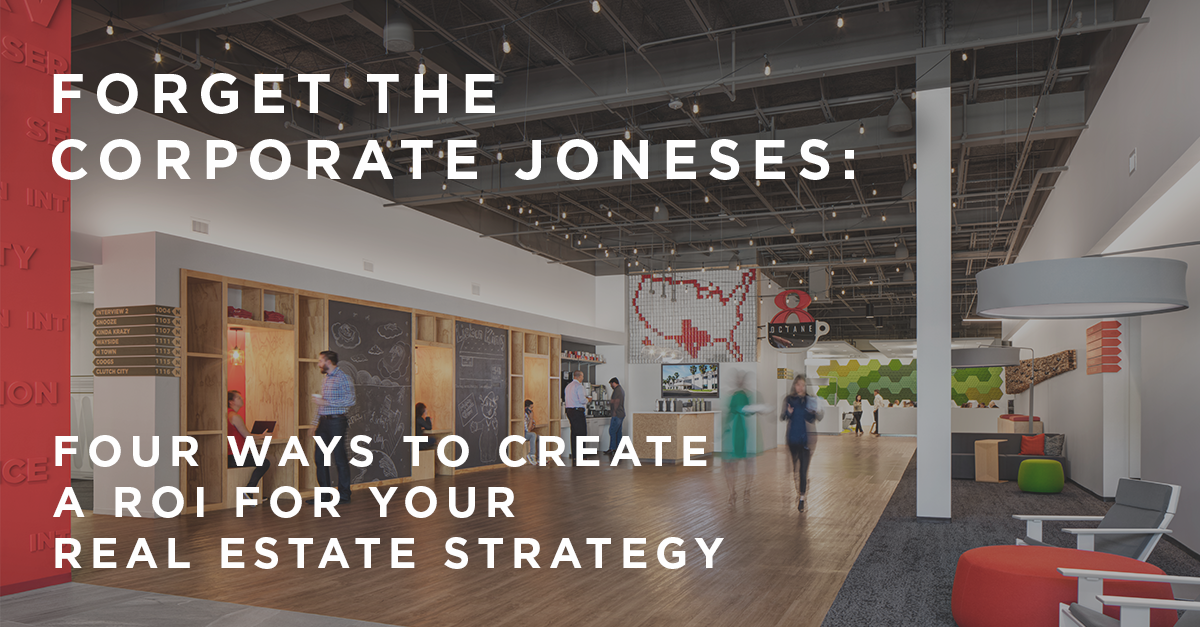
One of the most common questions we’re being asked is: “What have you been hearing about other companies’ plans for returning to work?” The truth is many businesses are currently caught up in a game of “not it!” – waiting to see what others are doing first before making any big decisions of their own. What’s become evident is the idea that there is no prescribed solution that makes sense for every business, so trying to keep up with the proverbial corporate Joneses could put a damper on future growth, employee satisfaction and retention. It can be tempting to benchmark successful companies to understand if your business’s future aligns.
We recently explained our timelining framework that promotes the use of historical context and real-time data collection to inform purposeful decisions for the future. Coupling benchmark information with targeted research specific to your company could yield a stronger understanding of your ideal real estate needs. For example, in our own microdata set, we found a $1.3m savings in our real estate needs over national data which was advising based on occupancy and preference. To put it simply: using the old model to determine our real estate needs would’ve been a costly mistake.
In the past, many companies have looked to “work from home” programs that failed and resulted in all employees being asked to return to the office, luring them with loaded snack bars and top-notch amenities. This begs the question – what‘s different now that will allow for a successful hybrid environment with a thriving physical office and frictionlessly intuitive digital platform? We‘ve been exploring concepts that will be important to build into your future work experience in order to optimize the transition to a hybrid ecosystem-based workplace. We’ve identified the following concepts as critical to building a thriving post-COVID hybrid work environment:
CHOICE – In this evolution of thought around the office and the changing work experience, we’ve shifted from thinking of space as a necessary expense to an investment with measurable returns. We’ve recognized the strategic advantages of the client experience and talent development when determining the variables of the investment. These strategic advantages are centered around people leveraging their capabilities through connection and culture. Offering the opportunity for employees to make intentional choices in a hybrid workplace ecosystem means adapting the physical space to accommodate current tasks. Also, it requires a culture of trust to allow employees the freedom to choose their work location and platform, as well as when and how they’re able to do their best work. Building trust in teams, across all levels, is key to making choice truly a personal preference facet of a hybrid work environment.
COMMUNICATION – Beyond offering the latest technology for collaborating and connecting across multiple platforms, engagement in learning and mentoring is essential. While working remotely, many have noted the strain on talent development tools. Our internal research reported that employees felt a decrease in teaching and learning moments with their supervisor because many opportunities for talent development happen in spontaneous conversation, which optimally happens in a person-to-person setting. And it’s no wonder, given that communication in the last year has occurred almost exclusively via digital platforms, which often requires a planned meeting. Recreating the aspects of impromptu learning and teaching moments to prosper on both digital and in-person platforms can bolster the effectiveness of your workplace toolkit. We can increase engagement by offering more learning opportunities through planned sessions on the digital platform and coordinating team days in the physical office.
EQUITY – The physical and digital platforms should work together to provide employees an equitable work experience, whether working remotely or in the office. Regardless of in-office or remote participation, a choice of platforms can’t limit employee voices, impact, contributions, opportunities to learn or perceived value to each other and the work done together. We can lean on technology to help recreate the feeling of “being together,” but company culture must fill the gaps where technology lags. In a recent study by Forbes, inclusive teams make decisions twice as fast with half the number of meetings and the decisions made and executed by diverse teams delivered 60% better results. To build an equitable experience and diverse teams, there needs to be space in the conversation for everyone. This includes the opportunity for open feedback when things aren’t working, and voices aren’t being heard in order to make improvements.
WORK/LIFE FLUIDITY – Since the introduction of email on cell phones, corporate desktops evolving into laptops as the norm, and growth of a global workforce, the clear delineation between work and home life has been challenged. Now, as more companies are exploring a potential hybrid setting, the separation of work and life is becoming even more muddied. With fewer people commuting to and from the office, the transition moments before and after the workday to gear up and wind down from the day have been eliminated. Acknowledging that there is no perfect balance of work and life due to fluctuating career demands and personal life, the aim is to create an equilibrium between the two. When designing your physical office and digital platform, it’ll be important to carve in moments that value that transition time. Encourage employees to power up their day with hospitality-focused moments like a specialty latte with a side of conversation in a casual setting, or power down their day by honoring a policy limiting meetings after 5 pm. Supporting the mental wellbeing of employees not only works against burnout rates but also advocates for personal satisfaction and retention.
The unprecedented nature of the pandemic didn’t exactly come with a handbook for business owners and leaders outlining how to manage the unknowns of working remotely or understand the direct impact on the workforce of the future – however, most have now realized the key to thriving (and not simply surviving) through the pandemic is adaptability and equity.



